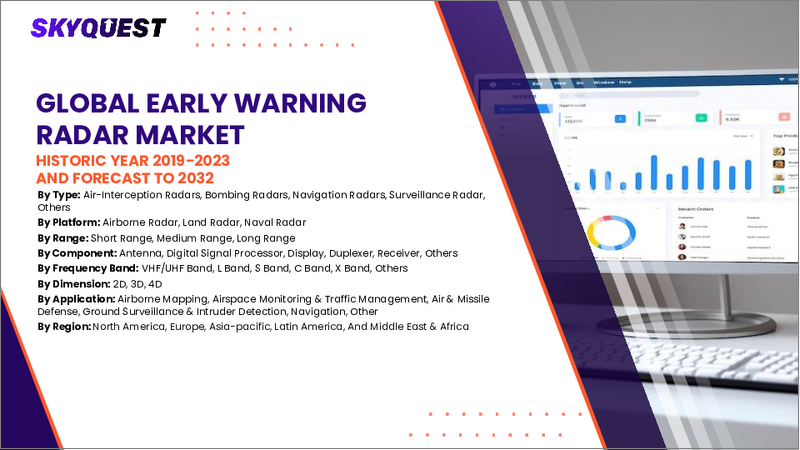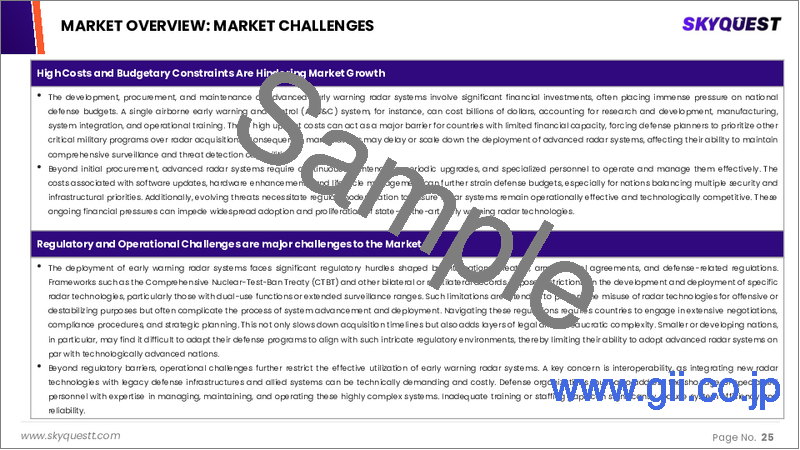|
|
市場調査レポート
商品コード
1796454
早期警戒レーダーの市場規模、シェア、成長分析、用途別、技術別、最終用途別、プラットフォーム別、地域別-2025年~2032年産業予測Early Warning Radar Market Size, Share, and Growth Analysis, By Application (Airborne, Ground-based), By Technology (Conventional Radar, Phased Array Radar), By End use, By Platform, By Region - Industry Forecast 2025-2032 |
||||||
|
|||||||
| 早期警戒レーダーの市場規模、シェア、成長分析、用途別、技術別、最終用途別、プラットフォーム別、地域別-2025年~2032年産業予測 |
|
出版日: 2025年08月18日
発行: SkyQuest
ページ情報: 英文 178 Pages
納期: 3~5営業日
|
全表示
- 概要
- 目次
早期警戒レーダーの世界市場規模は2023年に42億米ドルと評価され、2024年の42億9,000万米ドルから2032年には51億1,000万米ドルに成長し、予測期間(2025年~2032年)のCAGRは2.2%で成長する見通しです。
世界の早期警戒レーダー市場は、国家安全保障と軍事近代化の重視の高まりにより大きな成長を遂げています。防衛予算の増加と国境監視の需要増加がこの動向の主な促進要因です。AIベースの脅威検知を早期警戒レーダーシステムに統合することで、軍事および民間航空分野での採用が強化されています。さらに、防衛機関がミサイルや航空機などの空中脅威の早期特定を優先するため、高度な脅威検知機能が不可欠となっています。複雑な信号処理技術によって促進されるリアルタイムの脅威認識、長距離監視、マルチセンサー状況認識へのこのような焦点は、手動監視への依存を減らし、早期警戒レーダー市場を予測可能な将来に大幅に拡大するように位置づけています。
目次
イントロダクション
- 調査の目的
- 調査範囲
- 定義
調査手法
- 情報調達
- 二次と一次データの方法
- 市場規模予測
- 市場の前提条件と制限
エグゼクティブサマリー
- 世界市場の見通し
- 供給と需要の動向分析
- セグメント別機会分析
市場力学と見通し
- 市場概要
- 市場規模
- 市場力学
- 促進要因と機会
- 抑制要因と課題
- ポーターの分析
主な市場の考察
- 重要成功要因
- 競合の程度
- 主な投資機会
- 市場エコシステム
- 市場の魅力指数(2024年)
- PESTEL分析
- マクロ経済指標
- バリューチェーン分析
- 価格分析
- 技術分析
- ケーススタディ
早期警戒レーダー市場規模:用途別& CAGR(2025年~2032年)
- 市場概要
- 空挺
- 地上ベース
- 海軍
早期警戒レーダー市場規模:技術別& CAGR(2025年~2032年)
- 市場概要
- 従来型レーダー
- フェーズドアレイレーダー
- パルスドップラーレーダー
- FMCWレーダー
早期警戒レーダー市場規模:最終用途別& CAGR(2025年~2032年)
- 市場概要
- 防衛
- 航空宇宙
- 海事
- 国土安全保障省
早期警戒レーダー市場規模:プラットフォーム別& CAGR(2025年~2032年)
- 市場概要
- 軍用車両
- 船舶
- 航空機
- 無人航空機
早期警戒レーダー市場規模& CAGR(2025年~2032年)
- 北米
- 米国
- カナダ
- 欧州
- ドイツ
- スペイン
- フランス
- 英国
- イタリア
- その他の欧州
- アジア太平洋
- 中国
- インド
- 日本
- 韓国
- その他のアジア太平洋
- ラテンアメリカ
- ブラジル
- その他のラテンアメリカ
- 中東・アフリカ
- GCC諸国
- 南アフリカ
- その他の中東・アフリカ
競合情報
- 上位5社の比較
- 主要企業の市場ポジショニング(2024年)
- 主な市場企業が採用した戦略
- 最近の市場動向
- 企業の市場シェア分析(2024年)
- 主要企業の企業プロファイル
- 企業の詳細
- 製品ポートフォリオ分析
- 企業のセグメント別シェア分析
- 収益の前年比比較(2022年~2024年)
主要企業プロファイル
- Cohort plc
- Thales Group
- Lockheed Martin
- Textron
- DRS Technologies
- BAE Systems
- Honeywell
- Elbit Systems
- Northrop Grumman
- L3Harris Technologies
- General Dynamics
- Leonardo
- Boeing
結論と提言
Global Early Warning Radar Market size was valued at USD 4.2 billion in 2023 and is poised to grow from USD 4.29 billion in 2024 to USD 5.11 billion by 2032, growing at a CAGR of 2.2% during the forecast period (2025-2032).
The global early warning radar market is experiencing significant growth due to heightened emphasis on national security and military modernization. Rising defense budgets and an increasing demand for border surveillance are key drivers of this trend. The integration of AI-based threat detection with early warning radar systems has enhanced adoption across military and civil aviation sectors. Furthermore, advanced threat detection capabilities are becoming essential, as defense agencies prioritize the early identification of aerial threats, such as missiles and aircraft. This focus on real-time threat recognition, long-range surveillance, and multi-sensor situational awareness, facilitated by complex signal processing technologies, is reducing reliance on manual monitoring and positioning the early warning radar market for substantial expansion in the foreseeable future.
Top-down and bottom-up approaches were used to estimate and validate the size of the Global Early Warning Radar market and to estimate the size of various other dependent submarkets. The research methodology used to estimate the market size includes the following details: The key players in the market were identified through secondary research, and their market shares in the respective regions were determined through primary and secondary research. This entire procedure includes the study of the annual and financial reports of the top market players and extensive interviews for key insights from industry leaders such as CEOs, VPs, directors, and marketing executives. All percentage shares split, and breakdowns were determined using secondary sources and verified through Primary sources. All possible parameters that affect the markets covered in this research study have been accounted for, viewed in extensive detail, verified through primary research, and analyzed to get the final quantitative and qualitative data.
Global Early Warning Radar Market Segments Analysis
Global Early Warning Radar Market is segmented by Application, Technology, End use, Platform and region. Based on Application, the market is segmented into Airborne, Ground-based and Naval. Based on Technology, the market is segmented into Conventional Radar, Phased Array Radar, Pulse Doppler Radar and FMCW Radar. Based on End use, the market is segmented into Defense, Aerospace, Maritime and Homeland Security. Based on Platform, the market is segmented into Military Vehicles, Marine Vessels, Aircraft and Unmanned Aerial Vehicles. Based on region, the market is segmented into North America, Europe, Asia Pacific, Latin America and Middle East & Africa.
Driver of the Global Early Warning Radar Market
The rise in evolving security threats, including missile attacks, stealth aircraft, and unmanned aerial systems, has prompted state governments around the world to boost their defense budgets. This heightened focus on national security is driving demand for advanced early warning radar systems, which offer essential capabilities such as long-range detection, tracking, and real-time situational awareness. As nations prioritize the enhancement of their defense mechanisms, the adoption of innovative early warning radar technologies becomes crucial in effectively countering these emerging threats, thereby fostering significant growth within the global early warning radar market.
Restraints in the Global Early Warning Radar Market
The Global Early Warning Radar market faces significant constraints primarily due to the substantial investment needed for procurement, installation, and integration with current defense infrastructures. Additionally, ongoing costs associated with maintenance, system upgrades, and the necessary training of skilled operators contribute to the financial burden. These long-term expenses can impede the adoption of such advanced technology, particularly among smaller defense organizations and in developing nations that may struggle to allocate sufficient resources for these essential capabilities. As a result, the market experiences limitations in its growth potential and widespread implementation.
Market Trends of the Global Early Warning Radar Market
The Global Early Warning Radar market is witnessing a notable trend toward the integration of Artificial Intelligence (AI) and machine learning into radar technologies. This enhancement brings substantial advantages, such as improved target detection accuracy, minimized false alarms, and the ability to perform predictive threat assessments. As military and homeland security sectors increasingly recognize the value of advanced radar capabilities, the demand for AI-powered systems is surging. This trend emphasizes the importance of innovative technological solutions in enhancing situational awareness and operational efficiency, driving growth and investment in the early warning radar market globally.
Table of Contents
Introduction
- Objectives of the Study
- Scope of the Report
- Definitions
Research Methodology
- Information Procurement
- Secondary & Primary Data Methods
- Market Size Estimation
- Market Assumptions & Limitations
Executive Summary
- Global Market Outlook
- Supply & Demand Trend Analysis
- Segmental Opportunity Analysis
Market Dynamics & Outlook
- Market Overview
- Market Size
- Market Dynamics
- Drivers & Opportunities
- Restraints & Challenges
- Porters Analysis
- Competitive rivalry
- Threat of substitute
- Bargaining power of buyers
- Threat of new entrants
- Bargaining power of suppliers
Key Market Insights
- Key Success Factors
- Degree of Competition
- Top Investment Pockets
- Market Ecosystem
- Market Attractiveness Index, 2024
- PESTEL Analysis
- Macro-Economic Indicators
- Value Chain Analysis
- Pricing Analysis
- Technology Analysis
- Case Studies
Global Early Warning Radar Market Size by Application & CAGR (2025-2032)
- Market Overview
- Airborne
- Ground-based
- Naval
Global Early Warning Radar Market Size by Technology & CAGR (2025-2032)
- Market Overview
- Conventional Radar
- Phased Array Radar
- Pulse Doppler Radar
- FMCW Radar
Global Early Warning Radar Market Size by End use & CAGR (2025-2032)
- Market Overview
- Defense
- Aerospace
- Maritime
- Homeland Security
Global Early Warning Radar Market Size by Platform & CAGR (2025-2032)
- Market Overview
- Military Vehicles
- Marine Vessels
- Aircraft
- Unmanned Aerial Vehicles
Global Early Warning Radar Market Size & CAGR (2025-2032)
- North America (Application, Technology, End use, Platform)
- US
- Canada
- Europe (Application, Technology, End use, Platform)
- Germany
- Spain
- France
- UK
- Italy
- Rest of Europe
- Asia Pacific (Application, Technology, End use, Platform)
- China
- India
- Japan
- South Korea
- Rest of Asia-Pacific
- Latin America (Application, Technology, End use, Platform)
- Brazil
- Rest of Latin America
- Middle East & Africa (Application, Technology, End use, Platform)
- GCC Countries
- South Africa
- Rest of Middle East & Africa
Competitive Intelligence
- Top 5 Player Comparison
- Market Positioning of Key Players, 2024
- Strategies Adopted by Key Market Players
- Recent Developments in the Market
- Company Market Share Analysis, 2024
- Company Profiles of All Key Players
- Company Details
- Product Portfolio Analysis
- Company's Segmental Share Analysis
- Revenue Y-O-Y Comparison (2022-2024)
Key Company Profiles
- Cohort plc
- Company Overview
- Business Segment Overview
- Financial Updates
- Key Developments
- Thales Group
- Company Overview
- Business Segment Overview
- Financial Updates
- Key Developments
- Lockheed Martin
- Company Overview
- Business Segment Overview
- Financial Updates
- Key Developments
- Textron
- Company Overview
- Business Segment Overview
- Financial Updates
- Key Developments
- DRS Technologies
- Company Overview
- Business Segment Overview
- Financial Updates
- Key Developments
- BAE Systems
- Company Overview
- Business Segment Overview
- Financial Updates
- Key Developments
- Honeywell
- Company Overview
- Business Segment Overview
- Financial Updates
- Key Developments
- Elbit Systems
- Company Overview
- Business Segment Overview
- Financial Updates
- Key Developments
- Northrop Grumman
- Company Overview
- Business Segment Overview
- Financial Updates
- Key Developments
- L3Harris Technologies
- Company Overview
- Business Segment Overview
- Financial Updates
- Key Developments
- General Dynamics
- Company Overview
- Business Segment Overview
- Financial Updates
- Key Developments
- Leonardo
- Company Overview
- Business Segment Overview
- Financial Updates
- Key Developments
- Boeing
- Company Overview
- Business Segment Overview
- Financial Updates
- Key Developments






